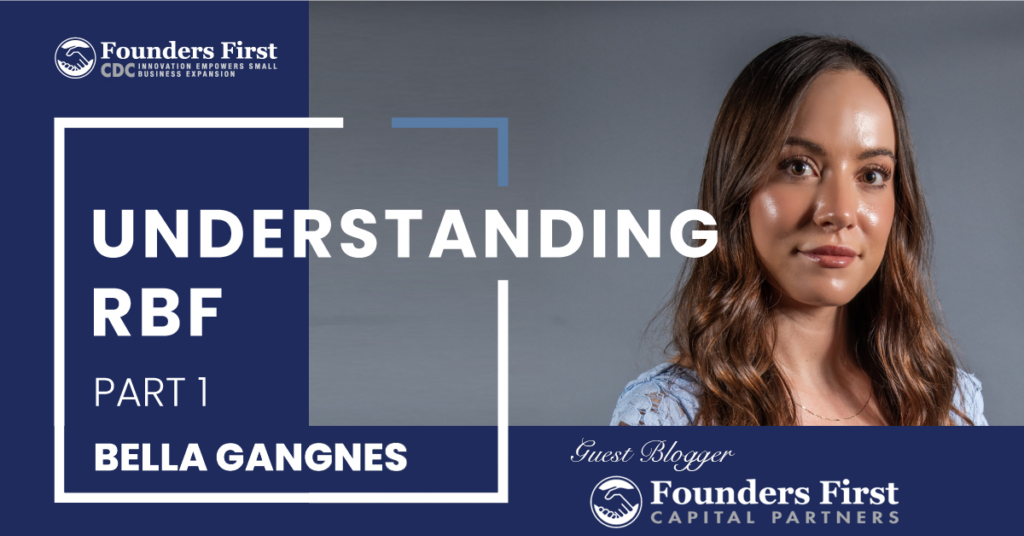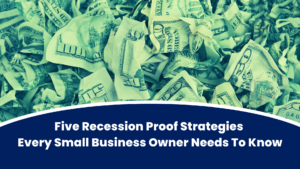Learn the ins and outs of revenue-based financing and if it might be a good fit for your business.
Guest blogger Bella Gangnes is the Senior Director of Investments for Founders First Capital Partners where she works with diverse founders to scale and grow their businesses. In this two-part series she discusses revenue-based financing and how Founders First Capital Partners evaluates businesses to help them grow.
At Founders First, we have a singular mission to empower traditionally underserved entrepreneurs by increasing access to resources. We do this through two sides of our business: one for strategic advisory and one for growth capital resources. In this article, I’m going to speak specifically to the capital side, where I lead our investment team and impact financing initiatives. This capital arm is where we have both an alternative and a complementary financing solution that can work tangentially with traditional funding sources like banks or equity.
What is revenue-based financing?
We offer a type of alternative lending called revenue-based financing (RBF). To further explain it in context, let me paint a picture of the capital market space for you. Historically, you have your traditional banks on one side and then you have your more institutional equity-based financing on the other side — both of which can be great options in certain situations for many companies. As an alternative lender and an impact investor, Founders First is really in this innovative middle ground between them.
We are going to be much less restrictive than a bank and much more flexible. We are not an asset-based lender; meaning we’re not going to care about the value of your house or your car for collateral, nor your personal credit score. We also aren’t going to have restrictive covenants in our deals making it so you have to have to maintain a certain level of cash in the bank, as an example. Compared to the other side of the market, we are fully non-dilutive as well: We’re completely out of your cap table, and not asking for any board seats, any control, or any equity dilution.
What business stages are best for RBF?
All that being said, there’s three common scenarios in which we are getting involved with businesses most often: First, as the primary and singular lender for a company that has never fundraised or taken outside capital before. Maybe they’ve predominantly been bootstrapped, funded growth with their own money, family and friends’ money, or business profits, and we can establish a relationship and act as their first long-term growth capital partner. Secondarily, we can also be used to bridge between formal equity rounds, acting as a type of bridge or mezzanine debt. In these instances, we diversify the capital stack by adding some additional fuel on the fire to help increase their valuation and position them even more favorably for their next formal equity round, all while retaining valuable ownership. Lastly, our money can be used to consolidate, clean up and refinance out less favorable, short-term and high-interest debt.
In all of these scenarios we also are very friendly with other predictable lenders, like traditional banks and the SBA. Oftentimes, we will be able to take a second, junior or subordinated lien position in the debt stack. Meaning that if a company has an existing SBA facility or term loan from Chase as an example — assuming the debt capacity and size of the business makes sense to us — we can act as a flexible complement and sit behind these in the debt stack and help diversify the capital sources.
Similar to a bank loan but with one key difference
Revenue-based financing is most similar to a bank term loan in the way that a full loan amount is advanced on day one, with repayment occurring on a monthly basis over a predefined term length. The key difference is that instead of a fixed monthly payment, the company is paying a fixed percent of their monthly revenue until a previously defined, capped repayment amount is reached. The term length functions as more of a rough outline of the required payback window — taking into account the company’s performance, projections and growth metrics — rather than a true maturity date. So, it’s much more variable. It creates this really dynamic partnership where our interests are aligned with yours because how well the company does in a month is proportional to how much they pay back on the loan.
Whether your revenue is $100,000 in one month or $40,000 the next, your payment is still the same percentage and you’ll pay less in a down month. Your payments to us ebb and flow with your revenue. Any sort of seasonality will be reflected in the way that the loan is paid back.
No equity, no collateralization
We don’t have an equity upside and we don’t collateralize any personal assets. The key way we’re able to get comfortable with our lending risk and the starting point for all of our analysis is going to be predictability of revenue. We’re very industry agnostic: our investments run the gamut of tech, SaaS, service-based businesses, light manufacturing and tech-enabled services consulting. It’s very broad, but the common denominator across the board is always going to be some level of repeatable, predictable, sticky revenue.
And that’s also how we assess debt capacity. We think of debt capacity for a given business as a percentage of that annual predictable revenue, typically ranging between about 15% to 30%. If a company is ending its fiscal year with a revenue of $1 million, we are able to get them a $200,000 loan, which is 20%. And then that principal amount would have a predetermined and fixed repayment cap that’s just a multiple of that principal. For example, 1.3 times the principal. Multiply it together, and that equates to a $260,000 obligation over the course of a predefined term––typically 2 to 5 years. And then every month you’re making one payment. That’s calculated by taking that single-digit fixed percent of monthly revenue until the $260,000 obligation is met.
Of course, there’s scenarios where you either under or over-perform the model and it’s looking like you’re going to pay it off sooner than three years, or like it’s going to go a little bit longer. In either situation, we will work with the company. We are an impact investor at the end of the day, so we’re going to check in with you regularly to ask, “Hey, should we refinance? Should we restructure? Should we add more capital and extend the term accordingly?” Those kinds of questions are always going to be at the forefront. It’s not a true maturity date. It’s kind of a term outline.
That’s how revenue-based financing with Founders First Capital Partners works. In Part 2, we’ll look at the metrics we use to evaluate companies we invest in.
If you think you might be a good fit for revenue-based financing, contact us at Founders First Capital Partners.




